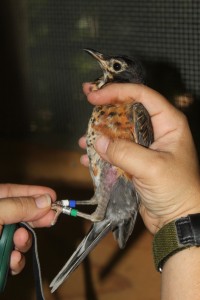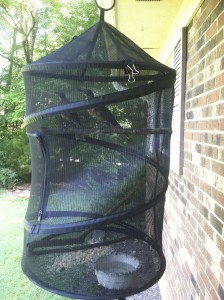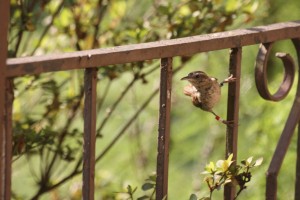This guest blog post is a short paper on an ongoing research project. Enter the world of creating and executing a research project. The authors describe their set up, the frustrating lack of initial results, and changes made to improve the study. I’m looking forward to seeing what this year will bring! – Kai
Guest writers Halley Buckanoff BS, CVT, CWR and Lynn J. Moseley, BS, PhD
The Valerie H. Schindler Wildlife Rehabilitation Center (VHS WRC) at the North Carolina Zoo, in partnership with faculty at Guilford College, has been conducting a post-release survival study of commonly rehabilitated backyard, non-migratory songbirds for four years to date. A search of the literature revealed few studies on post-release survival and/or behavior of hand-reared and rehabilitated songbirds (Berger 1966; Dunning 1988; Ferguson and Ludwig 1991). Anecdotal comments suggest that the behavior of hand-reared wild birds is sometimes distinguishable from that of their parent-reared counterparts as they act inappropriately for their sex or species, are unafraid of humans and/or continue to come to humans for food.
Seven species of birds were chosen for the study based on admission numbers at the VHS WRC and the potential for re-sighting released birds near feeders or around homes. All have non-migratory populations in North Carolina. The species chosen were American Robins (Turdus migratorius, AMRO), Blue Jays (Cyanocitta cristata, BLJA), Carolina Wrens (Thryothorus ludovicianus, CARW), Eastern Bluebirds (Sialia sialis, EABL), Mourning Doves (Zenaida macroura, MODO), Northern Cardinals (Cardinalis cardinalis, NOCA) and Red-Bellied Woodpeckers (Melanerpes carolinus, RBWO).
All study birds were admitted in their hatch year at fledgling stage or younger, and were hand-raised within the guidelines of the VHS WRC by trained staff, volunteers, and interns following standardized protocols for veterinary care as needed, husbandry, nutrition, and pre-release conditioning.

Prior to release, birds were banded with a numbered metal band and three colored bands in a unique combination for specific identification of individuals. Bird-banding is regulated by the United States Geologic Survey (USGS) and requires a federal permit; both authors possess federal licenses for bird-banding.
All post-release data was compiled through periodic observations of banded birds. If a released bird was re-sighted, we recorded behavioral data according to the following categories: Feeding (F), preening/bathing (P/B), carrying nesting material (CNM), resting (R), other comments (O). If feeding was observed, we noted whether it occurred at an established feeder. We also recorded whether the bird was with other banded or non-banded birds. We used this information to help determine whether a released bird demonstrated appropriate species-specific affiliations.
During 2010, the study’s first year, we attempted to engage the public to be “Citizen Scientists” and participate in the study. Birds were predominately released by the person who had rescued the bird and brought it to the VHS WRC. Birds were transported to their original capture site in vented paper bags and hard released. A total of 43 birds were banded with metal and color bands and released (Table 1). Unfortunately, no members of the public who released the birds reported any data, and upon inquiry the participants stated that they had not looked vigilantly for the banded birds.
Table 1. Species of birds and numbers of individuals of each species rehabilitated, banded, released, and re-sighted in each year of this study.
| YEAR | AMRO | BLJA | CARW | EABL | MODO | NOCA | RBWO | TOTALS | # birds resighted |
| 2010 | 18 | 3 | 3 | 13 | 1 | 2 | 3 | 43 | 0 |
| 2011 | 8 | 4 | 14 | 6 | 6 | 0 | 4 | 42 | 0 |
| 2012 | 12 | 1 | 5 | 2 | 1 | 5 | 2 | 28 | 1 NOCA |
| 2013 | 15 | 6 | 13 | 7 | 0 | 1 | 3 | 45 | 5 CARW |
| TOTALS | 53 | 14 | 35 | 28 | 8 | 8 | 12 | 158 | 6 |
The following year, in 2011, Volunteers/Interns at the VSH WRC conducted releases. Birds were again transported in vented paper bags to appropriate habitats and hard released. A total of 42 birds were metal and color banded and released (Table 1). But, once again no data was acquired due to lack of surveying for released birds.

In 2012, study birds were released and monitored by the two authors only, and only at two locations. Sites chosen offered suitable habitat for study birds (those species had been observed routinely at each site) and could be easily monitored. Feeders were maintained at both locations. In the first half of the season birds were transported in vented paper bags and hard released; at the second half of the season birds were transported in Exo Terra Explorariums® soft-sided hanging enclosures.
The enclosures were hung in visual distance of a feeder and left, depending on time of day, several hours to overnight. The door to the enclosure was then unzipped and the birds were allowed to leave at their own will. We referred to this release type as pseudo-soft release.
Of the 28 banded and released birds, one pseudo-soft released Northern Cardinal was repeatedly observed for 5 months post release. The ethogram results suggest that it exhibited appropriate behaviors for a normal wild bird.

Due to the encouraging results of 2012, the same techniques were used in 2013. Of the 45 birds banded and released, five Carolina Wrens (CARW) were seen repeatedly (Table 1). The first 4 CARW were released as a group and were seen on an almost daily basis for up to 3 months. The activity log included reports of interactions with non-banded CAWR, feeding at feeders as well as foraging in brush, and bathing/preening. The birds gave alarm calls when observers approached. The fifth wren was released at another date approximately 10 weeks later with another group of CARW and was seen almost daily for up to a month. Ethogram comments were the same as for the four wrens released earlier, but also included molting, at which time it was caught by a dog and succumbed.
This study is still in its early stages, as we continue to refine our techniques, and does not have enough data for statistical analysis at this point. However, as our techniques improve, we hope to increase the number of resightings, and possibly to include telemetry in the future. We believe that understanding the impacts of hand-rearing songbirds on their post-release survival will provide critical information for wildlife rehabilitators, and may serve to test the effectiveness of different techniques for successfully raising songbirds.
References:
Berger, A.J. 1966. Survival in the wild of hand-reared passerine birds. Condor 68:304-305.
Dunning, J.B. 1988. Significant encounters with marked birds. North American Bird Bander 13: 110-112.
Ferguson, Bruce and Daniel R. Ludwig. 1991. Post-release behavior of captive-reared American Robins (Turdus migratorius). Wildlife Rehabilitation 9: 193-205.
Product Information:
Explorarium®, Exo Terra, Rolf C. Hagen (U.S.A.) Corp., Mansfield, MA. 02048
Authors:
Halley D. Buckanoff, BS, CVT, CWR
Halley is the Lead Veterinary Technician at the North Carolina Zoo’s Valerie H. Schindler Wildlife Rehabilitation Center overseeing rehabilitation practices, center operations, and volunteers/interns. She graduated from Lewis and Clark College in Portland, OR with a Bachelor’s of Science in Biology. She is a Certified Veterinary Technician with 10+ years of emergency, exotic, zoo and wildlife medicine and husbandry experience. She has completed graduate level course work in animal population management and animal nutrition. She has worked as field biologist mist-netting, trapping, banding, tracking and radio-collaring birds. She is also the Association of Zoo and Aquarium’s North American Regional Studbook Keeper for Perodicticus potto (a small African monkey). She became a Certified Wildlife Rehabilitator in 2009 and has been a contract instructor for IWRC since 2010.
Lynn J. Moseley, B.S., Ph.D.
Lynn is Charles A. Dana Professor of Biology at Guilford College in Greensboro, North Carolina. She teaches courses in Ornithology, Animal Behavior, and Vertebrate Field Zoology, among others. She received her Bachelor’s of Science degree in Biology from the College of William and Mary, and her Ph.D. in Zoology from the University of North Carolina at Chapel Hill. Her main areas of interest include social behavior and communication of vertebrates, especially birds, and behavioral ecology.



Leave a Reply
You must be logged in to post a comment.